
Alfred Tennyson, 1st Baron Tennyson was an English poet. He was the Poet Laureate during much of Queen Victoria's reign. In 1829, Tennyson was awarded the Chancellor's Gold Medal at Cambridge for one of his first pieces, "Timbuktu". He published his first solo collection of poems, Poems, Chiefly Lyrical, in 1830. "Claribel" and "Mariana", which remain some of Tennyson's most celebrated poems, were included in this volume. Although described by some critics as overly sentimental, his verse soon proved popular and brought Tennyson to the attention of well-known writers of the day, including Samuel Taylor Coleridge. Tennyson's early poetry, with its medievalism and powerful visual imagery, was a major influence on the Pre-Raphaelite Brotherhood.
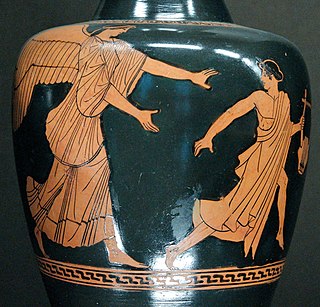
In Greek mythology, Tithonus was the lover of Eos, Goddess of the Dawn. He was a prince of Troy, the son of King Laomedon by the Naiad Strymo (Στρυμώ). The mythology reflected by the fifth-century vase-painters of Athens envisaged Tithonus as a rhapsode, as attested by the lyre in his hand, on an oinochoe of the Achilles Painter, circa 470–460 BC.
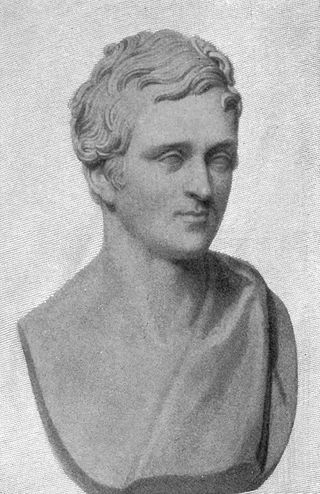
Arthur Henry Hallam was an English poet, best known as the subject of a major work, In Memoriam, by his close friend and fellow poet Alfred Tennyson. Hallam has been described as the jeune homme fatal of his generation.

"Ulysses" is a poem in blank verse by the Victorian poet Alfred, Lord Tennyson (1809–1892), written in 1833 and published in 1842 in his well-received second volume of poetry. An oft-quoted poem, it is a popular example of the dramatic monologue. Facing old age, mythical hero Ulysses describes his discontent and restlessness upon returning to his kingdom, Ithaca, after his far-ranging travels. Despite his reunion with his wife Penelope and his son Telemachus, Ulysses yearns to explore again.
Dramatic monologue is a type of poetry written in the form of a speech of an individual character. M.H. Abrams notes the following three features of the dramatic monologue as it applies to poetry:
- The single person, who is patently not the poet, utters the speech that makes up the whole of the poem, in a specific situation at a critical moment […].
- This person addresses and interacts with one or more other people; but we know of the auditors' presence, and what they say and do, only from clues in the discourse of the single speaker.
- The main principle controlling the poet's choice and formulation of what the lyric speaker says is to reveal to the reader, in a way that enhances its interest, the speaker's temperament and character.

Aurōra is the Latin word for dawn, and the goddess of dawn in Roman mythology and Latin poetry. Like Greek Eos and Rigvedic Ushas, Aurōra continues the name of an earlier Indo-European dawn goddess, Hausos.

The poem "In Memoriam A.H.H." (1850) by Alfred, Lord Tennyson, is an elegy for his Cambridge friend Arthur Henry Hallam, who died of cerebral haemorrhage at the age of twenty-two years, in Vienna in 1833. As a sustained exercise in tetrametric lyrical verse, Tennyson's poetical reflections extend beyond the meaning of the death of Hallam, thus, “In Memoriam” also explores the random cruelty of Nature seen from the conflicting perspectives of materialist science and declining Christian faith in the Victorian Era (1837–1901), the poem thus is an elegy, a requiem, and a dirge for a friend, a time, and a place.
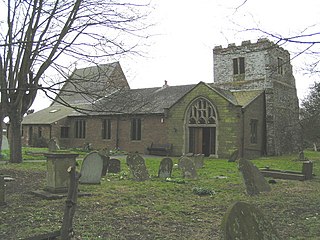
Mablethorpe is a seaside town in the East Lindsey district of Lincolnshire, England, part of the civil parish of Mablethorpe and Sutton. The population including nearby Sutton-on-Sea was 12,531 at the 2011 census and estimated at 12,633 in 2019. The town was visited regularly by Alfred, Lord Tennyson, a 19th-century Poet Laureate of the United Kingdom. Some town features have been named after him, such as Tennyson Road and the now closed Tennyson High School.

"The Charge of the Light Brigade" is an 1854 narrative poem by Alfred, Lord Tennyson about the Charge of the Light Brigade at the Battle of Balaclava during the Crimean War. He wrote the original version on 2 December 1854, and it was published on 9 December 1854 in The Examiner. He was the Poet Laureate of the United Kingdom at the time. The poem was subsequently revised and expanded for inclusion in Maud and Other Poems (1855).
"Crossing the Bar" is an 1889 poem by Alfred, Lord Tennyson. It is considered that Tennyson wrote it in elegy; the narrator uses an extended metaphor to compare death with crossing the "sandbar" between the river of life, with its outgoing "flood", and the ocean that lies beyond death, the "boundless deep", to which we return.
Nationality words link to articles with information on the nation's poetry or literature.

"Tithonus" is a poem by the Victorian poet Alfred, Lord Tennyson (1809–92), originally written in 1833 as "Tithon" and completed in 1859. It first appeared in the February edition of the Cornhill Magazine in 1860. Faced with old age, Tithonus, weary of his immortality, yearns for death. The poem is a dramatic monologue with Tithonus addressing his consort Eos, the goddess of the dawn.

The Princess is a serio-comic blank verse narrative poem, written by Alfred Tennyson, published in 1847. Tennyson was Poet Laureate of the United Kingdom from 1850 to 1892 and remains one of the most popular English poets.

"Oenone" or "Œnone" is a poem written by Alfred Tennyson in 1829. The poem describes the Greek mythological character Oenone and her witnessing incidents in the life of her lover, Paris, as he is involved in the events of the Trojan War. "Oenone" was inspired by Tennyson's trip to Spain, where he visited the Pyrenees mountains. It is considered the simplest of Tennyson's dramatic monologues.
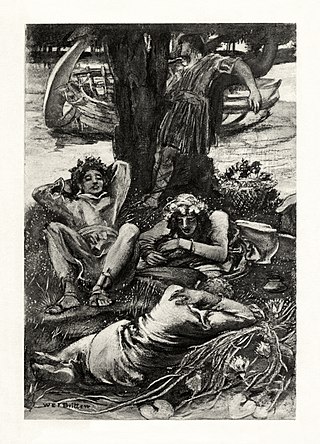
The Lotos-Eaters is a poem by Alfred Tennyson, 1st Baron Tennyson, published in Tennyson's 1832 poetry collection. It was inspired by his trip to Spain with his close friend Arthur Hallam, where they visited the Pyrenees mountains. The poem describes a group of mariners who, upon eating the lotos, are put into an altered state and isolated from the outside world. The title and concept derives from the lotus-eaters in Greek mythology.
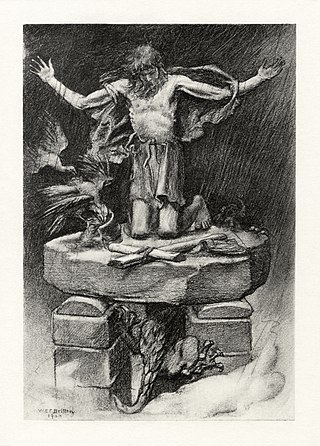
"St Simeon Stylites" is a poem written by Alfred Tennyson in 1833 and published in his 1842 collection of poetry. The poem describes the actions of St. Simeon Stylites, a Christian ascetic saint who recounts his various physical acts in hopes that he has earned his place in heaven. It captures Tennyson's feelings following the death of a close friend, Arthur Hallam, and contains feelings of self-loathing and regret. The work has ironic overtones that give it the appearance of a satirical work.
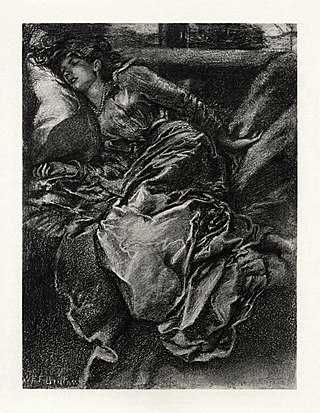
"The Day-Dream" is a poem written by Alfred Tennyson that was published in 1842. It was an expanded version of his 1830 poem "The Sleeping Beauty". It was further altered in 1848 for a dramatic performance for a private gathering with Tennyson starring as the Prince. "The Day-Dream" discusses the nature of sleeping and of dreaming, especially in relation to individuals that would want to escape from reality. The poem also compares the act of poetry with dreaming and asserts that the two are the same.

"Sir Galahad" is a poem written by Alfred Tennyson, 1st Baron Tennyson, and published in his 1842 collection of poetry. It is one of his many poems that deal with the legend of King Arthur, and describes Galahad experiencing a vision of the Holy Grail. The subject of the poem was later included in "The Holy Grail" section of Tennyson's Idylls of the King, but the latter version depicts Galahad as a pious individual who is grimly determined to fulfill his destiny. Sir Galahad, in contrast, depicts Galahad as proud, and has almost cheerful undertones.
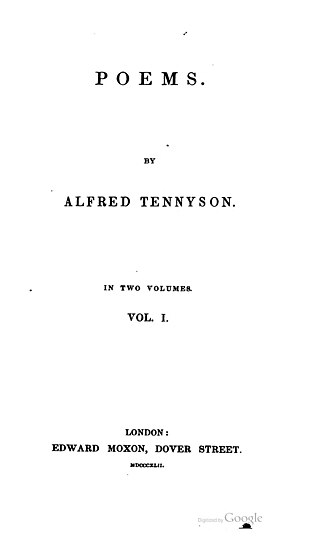
Poems, by Alfred Tennyson, was a two-volume 1842 collection in which new poems and reworked older ones were printed in separate volumes. It includes some of Tennyson's finest and best-loved poems, such as Mariana, The Lady of Shalott, The Palace of Art, The Lotos Eaters, Ulysses, Locksley Hall, The Two Voices, Sir Galahad, and Break, Break, Break. It helped to establish his reputation as one of the greatest poets of his time.

"St. Agnes" is a poem by Alfred Tennyson, first published in 1837, revised in 1842, and retitled "St. Agnes' Eve" in 1857.


















